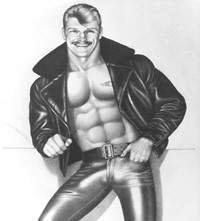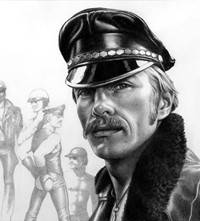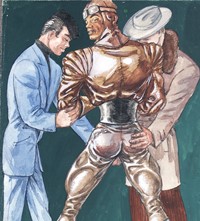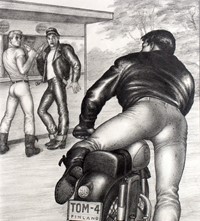Without Touko Laaksonen’s risqué illustrations, the landscape of queer art would look radically different. Here, we explore his influence on five different artists, from Robert Mapplethorpe to John Waters
- TextMiss Rosen
Even from a young age, Touko Laaksonen (aka Tom of Finland) was having erotic fantasies of grown men in his neighborhood. “I had a very strong fetish for some reason for leather and boots and all of it was combined with masculine professions and image,” Laaksonen said during a guest lecture at CalArts in 1988.
Mike Kelley had invited the Finnish artist to speak about the groundbreaking work he had done living in a nation where homosexuality was illegal until 1971 and laws forbidding the “promotion” of same-sex love were in effect until 1999 – eight years after his death.
Tom of Finland’s distinctive blend of beauty and lust inspired a generation of queer image-makers to openly embrace their identities in their lives and in their work. In honor of his vital legacy, Tom of Finland Foundation, Mike Kelley’s Mobile Homestead at the Museum of Contemporary Art Detroit, and Graeme Flegenheimer present TOM House: The Work and Life of Tom of Finland, a new exhibition that recreates his home in Echo Park, Los Angeles, where he spent his final years, showcasing works throughout his career alongside artists he inspired over the years.
The underlying theme of the exhibition is relationships: between artists and between men. For Tom of Finland Foundation curator Marc Ransdell-Bellenger, the connection is personal. “The very first Tom of Finland drawing I ever saw as a kid living in Kentucky is in this exhibition. It led me to realise I was not alone. It’s actually a G-rated drawing and it happens to be a drawing of Durk Dehner – my boss, my roommate, and my surrogate father,” he explains.
“I remember the day I was working in the vault and came across that drawing; I was instantly transported back to that day in Kentucky and was brought to tears because I suddenly realised I had become what I wanted to be and I escaped that oppressive environment to enjoy this freedom that I live in now.”
Here, Ransdell-Bellenger and Flegenheimer share insights into the artists inspired by the freedom to love and lust that Tom of Finland gave to the world.
Robert Mapplethorpe
In the late 70s/early 80s, Robert Mapplethorpe contacted Tom, asking to visit and see the men he was drawing for himself. Mapplethorpe spent a couple of weeks with Tom in Helsinki where they did a portrait exchange. The exhibition includes Mapplethorpe’s photograph of Tom. “The struck up a brief friendship,” Ransdell-Bellenger reveals. “Robert gave Tom one of his first major New York exhibitions – then ended up screwing him over and stealing work and money from him, so that severed their relationship. No surprise: Robert was a notorious asshole. Tom was a very trusting, genuine kind of guy and I don’t think he was used to being around that kind of ambition.”
John Waters
In the Tom of Finland XXL book from Taschen, John Waters gave a detailed description of meeting Durk Dehner and his unique experiences in TOM House: having a young leather-clad man to service him in any way he saw fit. The idea of home inspired the famed filmmaker to create a piece in tribute to Mike Kelley, a little vignette with a chair sitting next to a fireplace. “We are installing a fireplace in the mobile homestead to recreate the feeling of the Los Angeles house. It’s a sweet little gem,” Ransdell-Bellenger says. “One of the things we deal with is an open and honest sexuality. We don’t try to hide it. There’s no reason to. It’s one of the great reasons to live and celebrate who we are.”
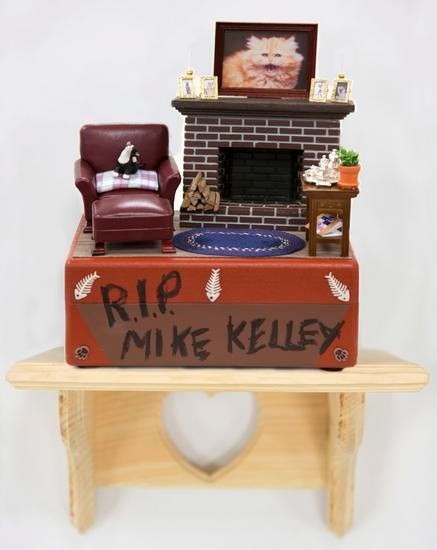
Jim Shaw
Mike Kelley and Jim Shaw were members of Destroy All Monsters, the Detroit punk/psychedelic/metal band that described their sound as “anti-rock.” “Mike was truly a weirdo and outcast in punk,” Flegenheimer reveals. “It makes sense that punks, misfits, and outcasts gravitated towards Tom and protected his legacy. Then finally the fine art world woke up and realised this was beyond erotic art, it was beyond gay – it was someone’s beautiful craft.”
Seth Bogart
As a member of the San Francisco punk band Hunx and His Punx, Seth Bogart draws inspiration from the men depicted in Tom’s work. “Music is an interesting through line in the exhibition. Essentially punk and the underground really preserved Tom until he got the acclaim from the fine art world,” Flegenheimer notes. “Seth is was very indebted to Tom’s men. His piece for the show is called Jerking Off, and it’s an oil-based piece of a man jerking off. A piece like that wouldn’t have existed without Tom’s contribution.”

Raymond Pettibon
For a long time, the art world did not know what to make of Tom’s work – but the punk scene, which had no rules, got it immediately. “Tom was this quintessential punk,” Flegenheimer explains. “Punk has been one of the main genres that has protected Tom during the more turbulent times of resistance for gay men when they were being persecuted.” Raymond Pettibon, one of the premier visionaries of the West Coast punk scene, supported and admired Tom’s work throughout his career. As the mastermind behind the Black Flag logo, record covers, and promotional flyers, Pettibon’s work is emblematic of the freethinking, D.I.Y. ethos of Tom’s oeuvre.
TOM House: The Work and Life of Tom of Finland will be on display at MOCAD from April 19–May 19, 2018).
